DS9 Forever (talk | contribs) No edit summary |
|||
| Line 138: | Line 138: | ||
{{bginfo|First appearing at the beginning of ''[[Star Trek: Voyager]]'' [[VOY Season 2|season two]] and the beginning of [[DS9]] [[DS9 Season 4|season four]], the Mark X tricorder was designed by HMS Studios. Like the previous evolution, it featured a number of additional LEDS along with a darker, more metallic coat of paint. Coinciding with a similar redesign of the [[phaser]]s, this new tricorder inexplicably found its way into the hands of the ''Voyager'' crew, despite the fact that it was stranded in the [[Delta Quadrant]]. It is possible that Starfleet programmed replicators to replace older tricorders throughout Starfleet with preprogrammed and predesigned upgrades through an automated upgrade process, or it could be that ''Voyager'' and the ''Equinox'' were test vessels for the new tricorders and phasers in 2371, and were not distributed fleet-wide until 2372.|Despite the introduction of yet another tricorder design in {{film|10}}, the Mark X seemed to continue to see use as late as [[2379]].}} |
{{bginfo|First appearing at the beginning of ''[[Star Trek: Voyager]]'' [[VOY Season 2|season two]] and the beginning of [[DS9]] [[DS9 Season 4|season four]], the Mark X tricorder was designed by HMS Studios. Like the previous evolution, it featured a number of additional LEDS along with a darker, more metallic coat of paint. Coinciding with a similar redesign of the [[phaser]]s, this new tricorder inexplicably found its way into the hands of the ''Voyager'' crew, despite the fact that it was stranded in the [[Delta Quadrant]]. It is possible that Starfleet programmed replicators to replace older tricorders throughout Starfleet with preprogrammed and predesigned upgrades through an automated upgrade process, or it could be that ''Voyager'' and the ''Equinox'' were test vessels for the new tricorders and phasers in 2371, and were not distributed fleet-wide until 2372.|Despite the introduction of yet another tricorder design in {{film|10}}, the Mark X seemed to continue to see use as late as [[2379]].}} |
||
| + | {{bginfo|In the ''[[Star Trek: Deep Space Nine]]'' game ''[[Star Trek: Deep Space Nine - The Fallen|The Fallen]]'', the player is able to use a TR-590 tricorder for a variety of purposes, including scanning people and objects and to determine shield frequencies.}} |
||
====Medical tricorder==== |
====Medical tricorder==== |
||
[[File:Mark X Medical Tricorder.jpg|thumb|The Mark X medical tricorder]] |
[[File:Mark X Medical Tricorder.jpg|thumb|The Mark X medical tricorder]] |
||
Revision as of 21:50, 26 June 2011
The Starfleet tricorder was the versatile, portable sensing device developed by Starfleet R&D specifically for use by Federation Starfleet personnel. Tricorders often times were outfitted with the latest technology of the century.
Varying models of the Starfleet tricorder were put into service, beginning as early as the 23rd century through the 24th century, possibly lasting well into the 29th century.
23rd century
2260s
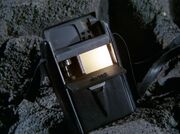
Starfleet tricorder, 2268
In service during the mid-2260s, the standard Starfleet tricorder incorporated a segmented design. This tricorder, a generally square-shaped device, utilized three sections: a pivoting upper portion containing the display readout and controls; a compartmented mid-section containing data chips; and an adaptable lower portion, sometimes containing a hand-held sensor as with the medical tricorder. The tricorder of the 2260s was mostly black with silver trim and featured a leather-like strap, allowing one to sling the tricorder over the shoulder when not in use. (TOS: "The Naked Time")
Yeomen serving aboard Starfleet starships (such as Janice Rand aboard the USS Enterprise) often carried tricorders in order to record and retrieve information for the starship captain. More often however, the tricorder was standard equipment included on away missions. (TOS: "The Man Trap", "Charlie X")
These devices could also be set to transmit an automatic distress call. (TOS: "That Which Survives")
One of the Dax hosts owned this version of the tricorder, remembered fondly by Jadzia Dax. (DS9: "Trials and Tribble-ations")
A heavier version of the tricorder was also used by landing parties and aboard ship. This configuration sported a pistol-grip and its controls were located on the top of the unit. It was used primarily to detect contamination caused by ores and gases, as well as to register radiation and atmospheric pressure. (TOS: "The Naked Time", "The Enemy Within", "The Doomsday Machine", "Obsession")
- See also psychotricorder and medical tricorder.
2270s
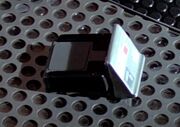
A tricorder in use aboard the refit Enterprise in the 2270s
With the widespread redesign of many facets of Starfleet and Federation technology in the early 2270s, so too did the tricorder advance toward a new design.
Smaller than that of the 2260s, the new hand-held Starfleet tricorder was blue-gray in color and featured two grips on either side of the body. Controls and readout displays were located beneath a lid at the top of the device. (Star Trek: The Motion Picture)
This type of tricorder was still in use in the 2280s. (Star Trek IV: The Voyage Home)
2280s
As early as 2285, Starfleet personnel like those serving aboard the refit starship Enterprise had at their disposal at least two distinct versions of the Starfleet tricorder.
Type A
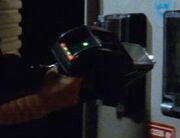
Heavy duty tricorder
Among the options was a heavy-duty tricorder, often used during landing parties. Bulkier than previous designs, this tricorder featured a handle and a large head featuring a line of blinking indicator lights. (Star Trek II: The Wrath of Khan)
Type B
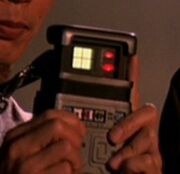
One tricorder option during the 2280s
Harking back to the designs of the 2260s, a second tricorder option in use during the mid-2280s featured a familiar square, black and silver design.
Much smaller than the heavy-duty version, this model featured a slide-up top studded with controls and indicator lights. Also incorporating a strap, the tricorder could be slung over the shoulder when not in use. Unlike its predecessors, this tricorder possessed control surfaces over much of the body of the instrument. (Star Trek III: The Search for Spock)
24th century
2360s
By the early 2360s, the Starfleet tricorder had taken on a more streamlined appearance, distinguished by a flip-open design maximizing both portability and interface surface availability.
Incorporating several sensor clusters, these tricorders featured multi-channel communications assemblies, and multiple databank modules. Encompassing visual displays and graphic touch pad interfaces, the tricorder of the 2360s provided easy means for on the spot archive retrieval, the recording of away mission events, and constant scientific measurements including biological, geographical or meteorological.
TR-560 Tricorder VI
Standard tricorder
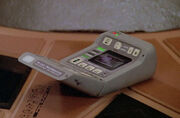
The TR-560 in 2365
In service as early as 2361, the TR-560 Tricorder VI model sensing device was available to officers serving aboard such vessels as the USS Victory and the USS Enterprise-D.
With an array of sensors on the front of the device, this tricorder design flipped open to reveal a large number of control surfaces and a square display screen, roughly the same size as those utilized as early as the 2260s.
Equipped with a small hand sensor, stowed below the sensors, the TR-560 tricorder was capable of communicating with non-Starfleet computer systems, and were therefore vulnerable to some computer viruses, even capable of transmitting them to other systems.
Gray in color, these tricorders were constructed with a durable casing, but could easily be destroyed by a phaser set to "disintegrate". (TNG: "Identity Crisis", "Encounter at Farpoint", "Angel One", "Contagion")
TR-580 Tricorder VII
Standard tricorder
The TR-580 in 2370
In service between 2366 and 2372, the Starfleet TR-580 Tricorder VII succeeded the TR-560 Tricorder VI. Retaining the same basic shape as the previous design, the TR-580s also incorporated hand sensors, but this feature was eventually phased out by 2370. (TNG: "Evolution"; DS9: "The Way of the Warrior")
TR-580s could be used for a variety of tasks, including recording time trials and playing holographic messages. This model featured a directory structure and built-in universal translator. (TNG: "Chain of Command, Part I", "The Chase", "Booby Trap", "Attached")
One version of the TR-580 used by Jadzia Dax in 2370 featured a larger screen on the upper section. (DS9: "Blood Oath")
To prevent interference with objects, the TR-580 could be set to perform a passive scan. The model could also be locked into a continuous scan, thereby recording data, even when stowed. Capable of communicating with non-Starfleet computer systems, the tricorder could be linked to other units, acting as a small computer network, easily relaying information to other locations. (TNG: "Schisms", "Brothers"; VOY: "Emanations", "Heroes and Demons")
Sensor emissions from TR-580s could cause unpredictable changes in certain temporal distortions, and sometimes included polaric fields, allowing a user to scan for subspace fractures caused by polaric detonation. (TNG: "Timescape"; VOY: "Time and Again")
TR-580s were stored in most equipment lockers aboard Federation starships though it was common for personnel to keep them in their quarters. (TNG: "Disaster", "A Matter of Time")
Starfleet sometimes distributed TR-580 model tricorders to Federation allied worlds, including Bajoran personnel on space station Deep Space 9. They could also be used by civilians, and were shipped en masse to areas in need, such as disaster sites. (TNG: "True Q"; DS9: "Babel", "Tears of the Prophets")
The standard TR-580 could function as a makeshift medical tricorder if necessary, although not all medical personnel were happy to do this. (TNG: "Time's Arrow, Part II"; VOY: "Caretaker")
Individuals were instructed in the use of the TR-580 by reading the tricorder operations manual. (VOY: "Phage")
Red tricorder
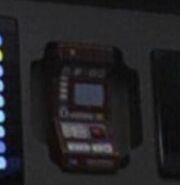
A red tricorder in 2371
A variety of the standard tricorder appeared in USS Voyager's sickbay in the year 2371. Five tricorders of this type were included in little alcoves behind the three biobeds and to the left and right of the main entry to sickbay. In 2372, these tricorders were replaced by PADDs. Similar tricorders were included in the same locations in sickbay aboard the USS Enterprise-E in 2373.
Medical tricorder
Medical TR-580 in 2369
Medical TR-580s used were essentially similar in design to that of the standard TR-580, with the same available features and interface. The major difference was the addition of a deployable hand scanner. While some standard TR-580s also had removable scanners, the medical TR-580s were much more advanced and could provide detailed scans of an entire individual, or give focus to a single area. (TNG: "When The Bough Breaks") It was not necessary to use the scanner for the TR-580 to function. The scanner could be separated from the tricorder, either to feed data to another source (TNG: "Up The Long Ladder") or not be attached to the tricorder at all. (DS9: "Babel")
The medical sensor unit was also equipped with additional sensor ports. (TNG: "Transfigurations")
The TR-580 medical tricorder was capable of recording audio. (TNG: "Cause and Effect")
The 24th century versions of the medical TR-580 were equipped with holographic imaging diodes. (TNG: "The Chase")
While the suite of sensors installed on medical TR-580s was advanced, it was generally no substitute for the advanced and specialized equipment in a sickbay facility. (TNG: "Genesis", "All Good Things...") Genetically-engineered microviruses were not generally detected by a standard medical TR-580 scan. (TNG: "The Vengeance Factor")
TR-580s could communicate with many Starfleet devices, including PADDs and starship library computers. They were also designed to work closely with the surgical support frames attached to biobeds. (TNG: "Identity Crisis", "Realm of Fear") In conjunction with a neural pad, a medical TR-580 could be used to link the nervous system of a healthy individual to that of an injured individual in order to stabilize the injured for transport. (TNG: "Transfigurations")
Medical TR-580s could be configured to briefly disrupt a force field. (TNG: "Attached")
2370s
TR-590 Tricorder X
Standard tricorder
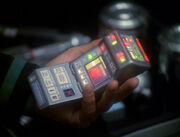
The TR-590 Tricorder X
Succeeding the TR-580 Tricorder VII, the TR-590 Mark X Tricorder featured nearly identical control interfaces. The entire unit, however, was streamlined and made much smaller, featuring a more angular design. (DS9: "The Way of the Warrior"; VOY: "Initiations")
Functioning very much like the previous model of Starfleet tricorder, the Mark Xs were stored in most equipment lockers on board Federation starships. (VOY: "Relativity")
Discovered by the Maquis, the Mark X tricorder could be prevented from attaining credible readings when subjected to concentrated thoron particles. (VOY: "Basics, Part II")
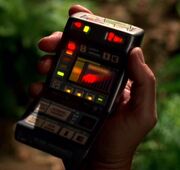
The darker cased TR-590 tricorder in 2378
The Mark X Tricorder was reportedly heavy for its size as indicated by B'Elanna Torres when she received a small gift from Tuvok during a holodeck generated baby shower. Torres asked if it was her child's first tricorder as the gift was small yet heavy. (VOY: "Human Error")
The Mark X tricorder could still function after being underwater. (DS9: "Rocks and Shoals"; Star Trek: Insurrection) It could also function in hostile environments such as temperatures of 500 Kelvin (VOY: "Demon") and planets suffering nuclear winter. (VOY: "Friendship One")
Despite being introduced in 2372, Mark X tricorders were already in use on board the USS Voyager during 2371. (VOY: "Relativity", "Fury", "Shattered")
Medical tricorder
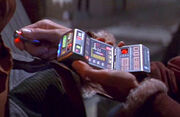
The Mark X medical tricorder
Introduced along with the Mark X standard tricorder, a medical tricorder variant was in use aboard Federation starships as early as 2373.
Generally identical to the standard tricorder, the medical featured a detachable hand scanner (as in previous models) that fit into the back of the unit. It was distinguished by blue ID indicator lights and a blue-glowing sensor surface. (Star Trek: First Contact; VOY: "Favorite Son"; DS9: "Soldiers of the Empire")
The medical tricorder had duritanium casing, and measured 7.6cm x 9.8cm x 3.2cm, and featured an alphanumeric display. (VOY: "Retrospect")
Wrist tricorder
A model of tricorder mounted in a arm/wrist brace was used in conjunction with holographic isolation suits during the Starfleet mission to the Baku homeworld in 2375. (Star Trek: Insurrection)
2379
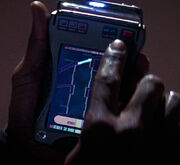
The Starfleet tricorder in 2379...
...and its medical counterpart
Introduced as late as 2379, yet another iteration of Starfleet tricorder departed from the distinct, flip-open style preceding it.
Distinguished by a slim, PADD-like appearance, the tricorder in use aboard such Starfleet vessels as the USS Enterprise-E in the late 2370s featured a large touchscreen interface. Silver in color, it was trimmed with black pads at the bottom and sides, with several buttons at the top. These buttons could be covered by a small hinged door, lined with indicator lights.
Among common data-gathering tasks, this version tricorder could be used to interface with starship systems including force field control.
The medical tricorder of the same make was identical. (Star Trek Nemesis)
Alternate tricorders
Tricorders have appeared to be in use well into the 25th and even 29th centuries. Their design and function, presumably similar to their 23rd and 24th century counterparts, may vary due to changes in the timeline.
2404
In an alternate timeline erased due to the actions of Admiral Kathryn Janeway, a new version of the tricorder was in use by the year 2404.
An extension of the Mark X model, this tricorder featured the familiar hinged cover design, but contained more touch control surfaces in place of toggle switches. The casing was black or dark-gray.
The medical tricorder variant featured a small antenna scanner. (VOY: "Endgame")
2800s
During a possible version of the 29th century, the crew of the USS Relativity used a slim and sleek version of the tricorder, labeled a TR-890 Tricorder XV. Seven of Nine was given a TR-890 as she hunted for a temporal disruptor hidden on Voyager by Captain Braxton. (VOY: "Relativity")
In addition to the TR-890, a smaller, palm-sized device was in use during this period. Henry Starling found one aboard the Aeon and carried it with him at all times. He used it in an attempt to escape Voyager's transporter when the ship tried to retrieve the Aeon in 1996. (VOY: "Future's End, Part II")


